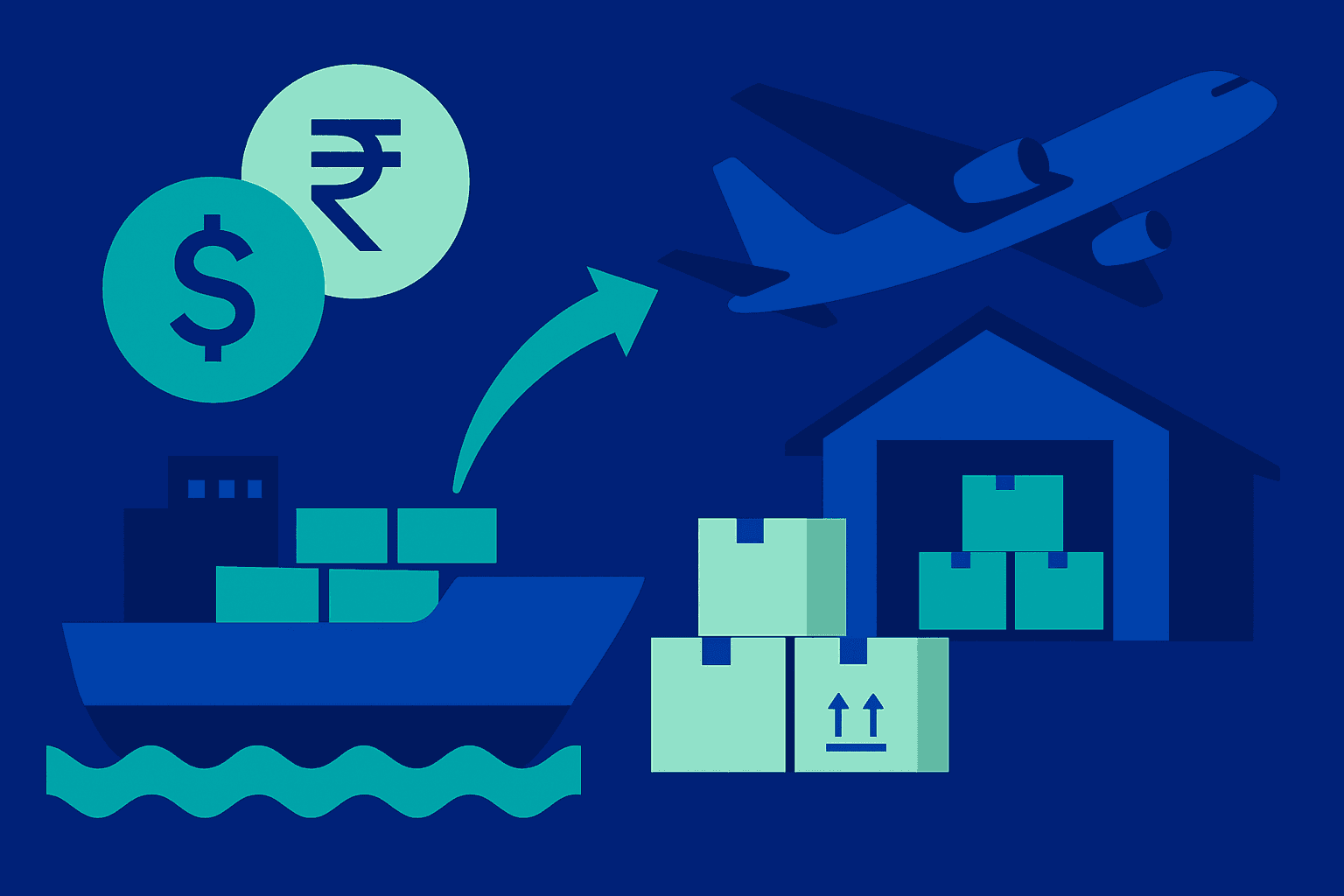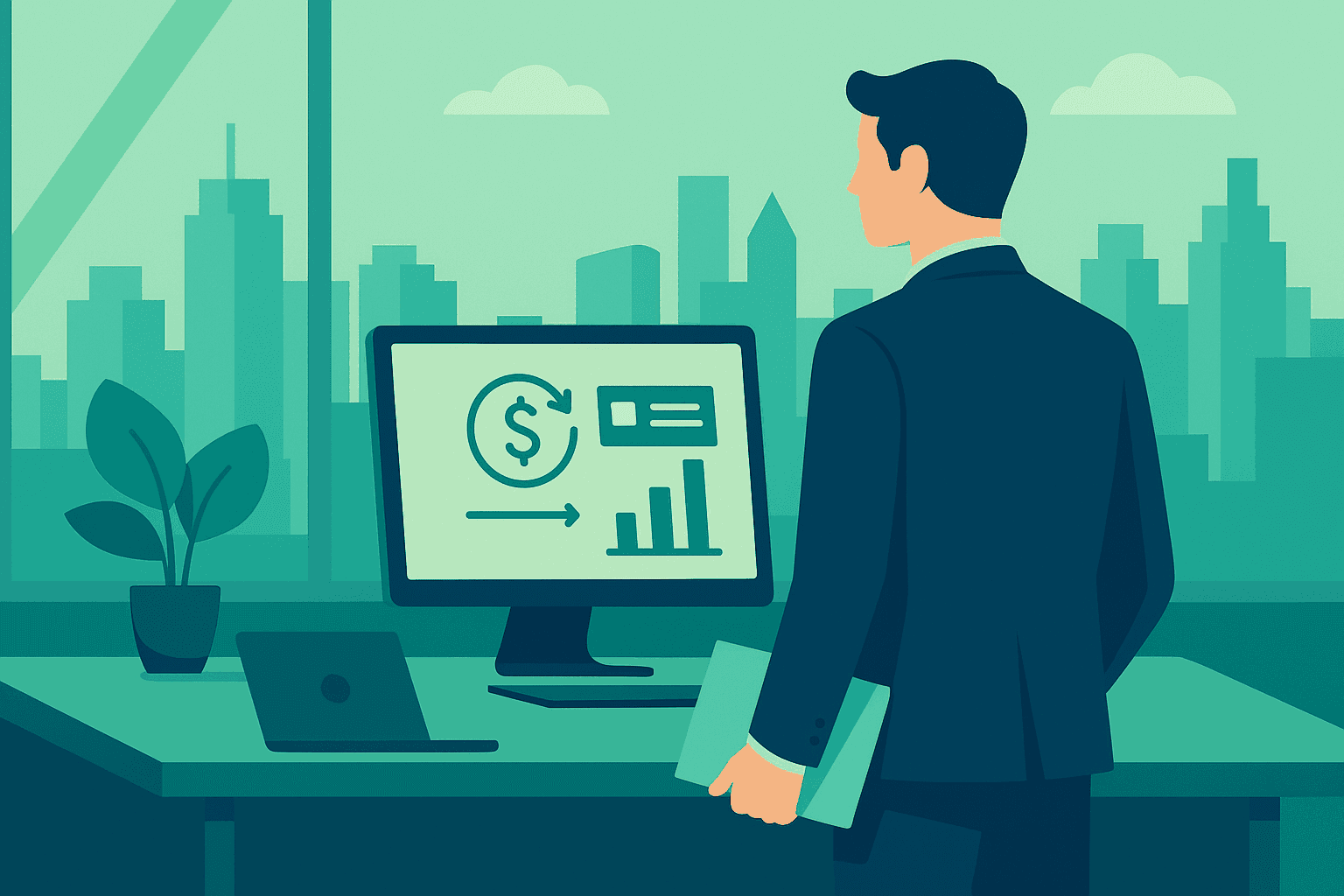How Indian Sellers Can Reduce Amazon Seller Fees in 2025

Selling globally on Amazon is a game-changer for Indian businesses, but it comes at a cost. From Amazon’s referral commissions to hefty currency conversion markups, fees can eat into your profits. In this guide, we break down every Amazon seller fee you must know for 2025 and share practical tips to reduce these fees. Whether you’re new to Amazon Global Selling or looking to boost your margins, read on to ensure you’re not leaving money on the table.
Overview: What Does It Cost to Sell on Amazon Globally?
Here's a quick snapshot of what you have to pay to sell on Amazon globally:
| Type of fees | Range of fees |
| Selling Plans | $0.99/product to $39.99/month |
| Referral Fee | Ranges between 5%-45% depending on the product |
| Closing fee (for media items) | $1.80 per unit sold |
| Rental Book Service Fees | $5.00 for each rental |
| High volume listing fees | $0.001 per SKU is applied |
| FBA Fulfilment fee (Optional) | $3-$200/unit depending on product |
| Advertisement and other service fees | These are optional services, and the the fees depend on the kind of services you are availing |
Some Amazon fees are non-negotiable; they’re the cost of doing business on the platform. But many others, like fulfillment, storage, and conversion charges, can be reduced with smarter planning, better tools, and the right partners. The key is knowing which ones you can control and how.
Amazon Seller Fees Breakdown (2025) – Detailed Fees Explanation
In this section, we will give a detailed breakdown of each of these fees and see if there's a way to optimize those.
Selling Plans:
Amazon offers two types of selling plans depending on the size of your business:
- Professional Plan: Ideal for established sellers with high sales volumes, this plan costs $39.99/month. It includes access to advanced tools like advertising, bulk inventory management, and the ability to sell restricted products.
- Individual Plan: Best for new sellers or those selling fewer than 40 units per month, this plan charges $0.99 per product sold. However, it doesn’t include features like advertising or the ability to sell certain restricted items.
Tips to reduce fees: Choose the right selling plan based on your volume. If you sell fewer than 40 items a month, the Individual plan (with a per-item fee) keeps costs low. But if you're scaling or consistently selling more, the Professional plan waives per-item charges and unlocks bulk listing tools, saving you more in the long run.
Referral Fees
In addition to the selling plan, Amazon charges a referral fee on the item price for every product sold. Think of it as Amazon seller commission. This fee is a percentage of the total sale price or a minimum flat amount, whichever is higher, and these fees vary based on product categories.
For example:
- Compact Appliances: Referral fees range between 8% and 15% of the sale value.
- Watches: The referral fee is 16% and a further 3% may be levied depending on the price range.
Tip to reduce fees: Factor Amazon’s referral fees into your pricing from day one. Since these fees vary by category (some go as high as 45%), avoid low-margin products in high-fee categories unless you’re confident about volume. Also, watch for fee jumps at certain price points. For example, if watches above ₹5,000 have an extra 3% fee, pricing just under that can save you more than you’d expect
Other Amazon Fees (Closing Fee, High-Volume Listing, etc.)
Closing Fee
Media items are charged a closing fee for each unit sold in addition to other fees. These items include: Books, DVD, Music, Software & Computer/Video Games, Video Game Consoles, and Video Game Accessories. The closing fee is $1.80 per unit sold for products in these categories.
Rental Book Service Fees
If you offer textbook rentals on Amazon, you’ll have to pay a rental book service fee of $5.00 for each rental as part of Amazon Seller fees.
High-Volume Listing Fees
If you have a large number of active, non-media listings that haven’t sold in 12 months, Amazon charges a monthly fee of $0.005 per eligible listing to cover cataloguing costs. The first 100,000 listings are, however, exempt from this fee.
Tips to Reduce Fees: Regularly clean up your listings. Remove inactive SKUs that aren’t moving to prevent high-volume listing fees and keep your account healthy.
While these Amazon seller fees apply to all sellers, there are additional charges for optional services. One such service is Fulfillment by Amazon (FBA), which many exporters use to streamline shipping and logistics. Understanding these optional fees is just as important. Here’s a breakdown,
Amazon FBA fees
Logistics is a critical part of ensuring your products reach customers on time and in top quality. As an Amazon Global Seller, you have two options for shipping:
- Fulfilment by Amazon (FBA): Amazon takes care of picking from the Amazon FBA warehouses, packing, shipping, order delivery, and returns.
- Merchant Fulfilled Network (MFN): You handle all logistics yourself through your chosen vendor.:
You have two options here:
- Third-Party Warehouse– Ship your inventory to their warehouse, and they handle packing, picking, and delivery.
- Self-Ship at Parcel level– Keep the goods in your warehouse in India and ship them directly as orders come in. So here, you'll have to pay the shipping fee, pack fee etc separately.
If you don’t have a robust logistics setup and looking for an easy ship option, FBA can be a great option to save time and reduce the stress of managing export logistics. Here’s a breakdown of FBA fees:
FBA Fulfillment Fee
This Amazon seller fees covers picking, packing, shipping, handling, customer service, and returns. The costs depend on your product's volumetric weight, dimensions, and category (e.g., apparel vs. non-apparel).
- Small-Tier Products (e.g., phone covers): Fee ranges from $3.06 to $3.65 depending on weight.
- Large Standard Products (e.g., irons) :Fee ranges from $3.68 to $7 based on weight.
- Extra-Large Products (over 68 kg): Fees can exceed $200 per unit.
- Apparel Products: Fulfillment fees are slightly higher. For example: Small Apparel: Up to $3.98 Large Apparel: Up to $7
- Higher fees apply to items classified as dangerous goods.
You can get the complete list of FBA fulfilment fees as per product sizes right here.
Tips to reduce fees: Be strategic with fulfillment. If a product has low margins or sells slowly, use self-fulfillment (MFN) to avoid FBA fees. Save FBA for fast-moving, high-margin items where Prime boosts sales. Also, optimising your packaging, reducing product size or bundling smartly, can keep you in a lower weight tier and cut fees significantly.
Advertisement Fees
To promote your products on Amazon, you can leverage their advertising services. This program allows you to run impactful campaigns directly in the Amazon store, with the flexibility to set your own bids and budgets.
Amazon offers a range of ad formats, including video, audio, and display ads, tailored to fit different marketing needs. Most Amazon ads operate on a Cost Per Click (CPC) model, meaning you only pay when someone clicks on your ad. Learn more about it here.
Tips to reduce fees: Use promotions strategically. Do not rely solely on fee-based promos; sometimes investing in Amazon PPC ads (which at least directly drive sales) might yield better ROI than spending on a coupon that now also incurs a percentage fee.
Other Service Fee
Amazon also offers a range of additional services like Buy with Prime and Amazon Customer Service. The Amazon seller fees for these services vary based on the specific options you choose and your business needs.
Hidden Fee: Withdrawing Your Amazon Earnings (Forex & Conversion Costs)
Once Amazon pays you (after all the above fees), there’s another cost many sellers overlook: Getting your money back to India. There are primarily two ways through which you can withdraw your Amazon earnings:
- Use Amazon’s Currency Converter for Sellers (ACCS)
- Withdraw through third-party platforms like Skydo, Payoneer, or PingPong: To use a third-party platform like Skydo or Payoneer, you’ll need to sign up, create a US virtual bank account, and add it to your Amazon Seller account. Skydo provides a US virtual account in under 5 minutes, while other platforms may take a few days
Let’s break down the costs of withdrawing your earnings through each platform.
Amazon Currency Converter Fees
As an Indian exporter on Amazon, you can use Amazon’s Currency Converter for Sellers (ACCS) to withdraw your earnings. Amazon automatically converts your payments into INR and deposits them into your bank account within 1-5 business days.
You can receive payments in 20+ currencies without needing a foreign bank account. However, the conversion comes at a cost. Amazon uses a volume-based pricing model, which means the higher your earnings, the lower the conversion fee. Also, note that the volume-based pricing is based on your total cross-currency net proceeds during the past 12 months. Here’s how the pricing works:
| Net Proceeds (USD) | Volume-based pricing (fx markup extra) |
| Less than $100,000 | 1.50% |
| $100,000 - $500,000 | 1.50% |
| $500,000 – $1,000,000 | 1.25% |
| $1,000,000 – $10,000,000 | 1.00% |
| $10 million+ | 0.75% |
Let’s break this down with a real example.
Say you earned $200,000 last year after deducting all applicable fees. If you choose to withdraw using Amazon’s Currency Converter, here’s what happens:
- Amazon charges a 1.50% conversion fee based on your earnings. That means you immediately lose $3,000 (₹2,59,500) right off the top, leaving you with $197,000.
- This $197,000 is then converted to INR, but not at live forex rates. Amazon typically applies a 1-2% forex markup.
- So, if the market exchange rate is $1 = ₹86.5, Amazon's banking partner might offer you ₹85 per USD.
- Instead of getting ₹1,70,40,500, you receive ₹1,67,45,000, meaning you lose another ₹2,95,500 due to the lower exchange rate.
Total Cost of Using Amazon’s Currency Converter:
₹2,59,500 (conversion fee) + ₹2,95,500 (forex loss) = ₹5,55,000 lost
5.5 lakh (over $7,000) is lost to conversion when using Amazon’s default method. That’s money the seller could have kept
Payoneer & PingPong Fees
Payoneer and PingPong are well-known platforms for cross-border payments, helping exporters worldwide withdraw their Amazon Global Selling earnings directly into their bank accounts. But how much does it really cost?
Both platforms charge:
- 1% transaction fee on your earnings
Let’s break this down with the same $200,000 earnings example:
Let’s break this down with the same $200,000 earnings example:
- 1% transaction fee = $2,000 (₹1,73,000), leaving you with $198,000
- Considering the forex rate to be INR 86.5 for $1, you will receive $198,000*86.5 = INR 1,71,27,000 in final payments
So, you have to pay 2000 dollars or INR 1,73,000 in fees while withdrawing your earnings via Payoneer or PingPong.
Skydo Fees
Skydo is an Indian-origin, RBI authorised cross-border payments platform designed to help Indian exporters maximize their international earnings. With direct integration with Amazon Global Selling, Skydo allows you to withdraw funds at live forex rates with minimal fees—ensuring you keep more of your hard-earned money. Find out how
How Much Does It Cost with Skydo?
Skydo charges:
- 0.5% for monthly transactions below $10,000
- 0.3% for monthly transactions above $10,000
Unlike Amazon and other third-party platforms, Skydo applies zero forex markup. This means if the live exchange rate is ₹86.5 per USD, your funds are converted at that exact rate—without any deductions.
Example: Withdrawing $200,000 via Skydo
- Skydo’s fee (0.3%) = $600 (₹51,900)
- Remaining balance after fee = $199,400
- Converted at live forex rate (₹86.5 per USD) = ₹1,72,48,100
With Skydo, you only pay a flat $600 (₹51,900) and don’t lose a single rupee to hidden forex markups—making it the most transparent and cost-effective way to withdraw your Amazon earnings.
Tip to Reduce Fees: To save 50% or more on your Amazon payout fees, consider using Skydo or a similar RBI-authorized platform instead of Amazon’s default. Skydo users get live forex rates, zero markup, and only a tiny transaction fee, as the example shows. Sign up now to retain more of your earnings.
Tips to Reduce Amazon Seller Fees and Boost Profit
- Choose the Right Seller Plan: Don’t pay for a Professional plan if you’re selling only a few items; use the Individual plan until sales. Conversely, if you’re doing high volume, the monthly fee is worth it to avoid per-item charges. grow
- Optimize Pricing to Account for Referral Fees: Calculate your profit after Amazon’s cut. If a category has an exceptionally high fee, factor that into your pricing strategy or focus on products with more standard fees.
- Use FBA Judiciously: FBA can increase sales, but it comes with fees. Use it for items that benefit most (fast sellers, Prime demand), and consider FBM (self-fulfillment) for others to save on fulfillment fees. Also, minimize FBA storage fees by keeping inventory lean – use Amazon’s inventory tools to track and remove slow-moving stock.
- Reduce Product Size/Weight if Possible: Lighter, smaller packaging can push your FBA fee to a lower bracket (for example, staying under 1 lb or under certain dimensions can save a dollar or more per unitskydo.com). This might involve design tweaks or bundling items as one kit instead of multiple listings (selling in bundles can also save referral fees in some cases by selling one higher-priced item vs multiple lower-priced ones).
- Avoid Unnecessary Promotions: Since 2025’s new rules may hike promo costs, reserve Lightning Deals/Coupons for when you need a sales boost, and monitor their ROI. Don’t run them constantly or you’ll pay hefty new fees. Often, a well-optimized listing with targeted ads can drive sales without those extra promotion fees.
- Minimize Returns and Refunds: Provide clear product info and quality to avoid returns (which can cost you refund administration fees and lost referral fees). While returns are part of business, fewer returns mean less revenue reversal.
- Join Amazon’s Brand Registry (if eligible): Brand-registered sellers gain access to tools like Vine reviews, Enhanced Brand Content, etc. While this doesn’t directly cut fees, it can boost conversion rates and sales, helping you absorb fixed costs like FBA/storage better. (Also, brand owners might get some protection like free replacements for fraud-related returns, etc., which indirectly saves money.)
- Leverage Third-Party Logistics: If FBA fees are too high for your product (e.g., oversized items), you can use a 3PL in the target country or Amazon’s new Global Logistics program to perhaps lower shipping costs while still fulfilling in a timely manner (this is a complex tip, but worth mentioning that alternatives exist).
- Use a Low-Cost Payment Provider for Payouts: As discussed, avoid losing 3-5% in forex conversion. Using a service like Skydo can reduce your payout fees by up to 90%
- Stay Informed on Fee Changes: Amazon updates its fee structures periodically (often annually). For instance, storage fees might increase during holidays, or new fee categories (like the promotional fees in 2025) can appear. By staying informed (through Amazon announcements or blogs like this), you can proactively adjust your strategy (e.g., clear out inventory before long-term fee kicks in, or raise prices slightly if Amazon raises referral fees).
Save on Amazon Seller Fees with Skydo
Amazon and third-party platforms like PingPong and Payoneer eat into your earnings with hidden forex markups and hefty withdrawal fees. Skydo changes that. With live forex rates and transparent pricing, you keep more of what you earn.
Plus, every global payment comes with free, instant FIRA, and if you ever need help, our India-based support team has your back.
Why let unnecessary fees eat into your profits? Switch to Skydo today and maximize your Amazon Global Selling earnings.
What percentage does Amazon take in fees?
It depends on product category, but most sellers pay a referral fee of 15% on Amazon.com (some categories lower or higher)wix.com, plus fulfillment fees if using FBA, etc. We list all fees in the guide above.
How much does it cost to sell on Amazon global from India in 2025?
Do Indian sellers have to pay extra to sell on Amazon US/UK?
Are Amazon fees different in 2025 vs 2024?












